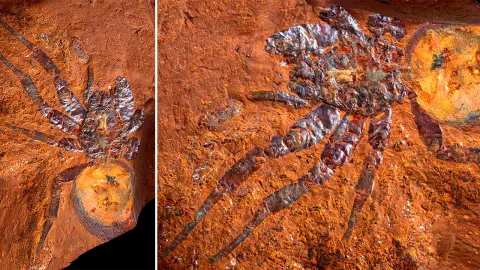A new fossilized spider, which lived millions of years ago, was discovered in Australia. This is Megamonodontium mccluskyi, an arachnid five times larger than the most similar contemporary specimen. The fossil is one of the great treasures of national paleontology as it is part of the only four remains of fossilized spiders discovered in its territory. Megamonodontium mccluskyi lived during the Miocene period in Australia, when the territory was a tropical rainforest and was in a different location than today. According to the characteristics of the fossil, this spider belonged to the genus Barychelidae, whose members are known as trappers. The arthropods of that family build trap burrows in the ground or wood and use their bulging bodies to seal their hiding places.
The fossil shows a specimen noticeably larger than trapdoor spiders that exist today. It measures approximately 50 millimeters from tip to tip, while the common trapper arthropod has an average size of 10 millimeters. The Megamonodontium is the second largest spider record in the world and the largest found in Australia. It is also the second preserved vestige of a mygalomorphic arachnid in its country of origin and the fourth recorded fossil of the species. It was discovered at the McGraths Flats paleontological site, with an estimated age between 11 and 16 million years.
The closest living relative of this species lives in the humid forests of Singapore and Papua New Guinea. The difference in the geographic distribution of these specimens suggests that Australia’s prehistoric trapdoor spider became extinct as the territory acquired its characteristic arid climate. The discovery of the trace helps fill an important gap in the evolutionary history of spiders in Australia.
The territory has experienced significant changes over millions of years due to continental drift and the activity of the Indo-Australian tectonic plate. “Without fossils, researchers could only rely on phylogenetic analyzes of modern species to infer the evolutionary history of mygalomorph spiders. These analyzes suggest that the Miocene was a time of particularly high divergence in this group.
During that time, Australia was experiencing widespread aridification that led to the contraction of rainforest environments and the establishment of the current arid biome,” the report explains. The remains were discovered by Dr. Simon McClusky. The name Megamonodontium mccluskyi is made up of the words ‘mega’, meaning large, ‘monodontium’, the genus of arachnids, and ‘mccluskyi’, in honor of its discoverer.







